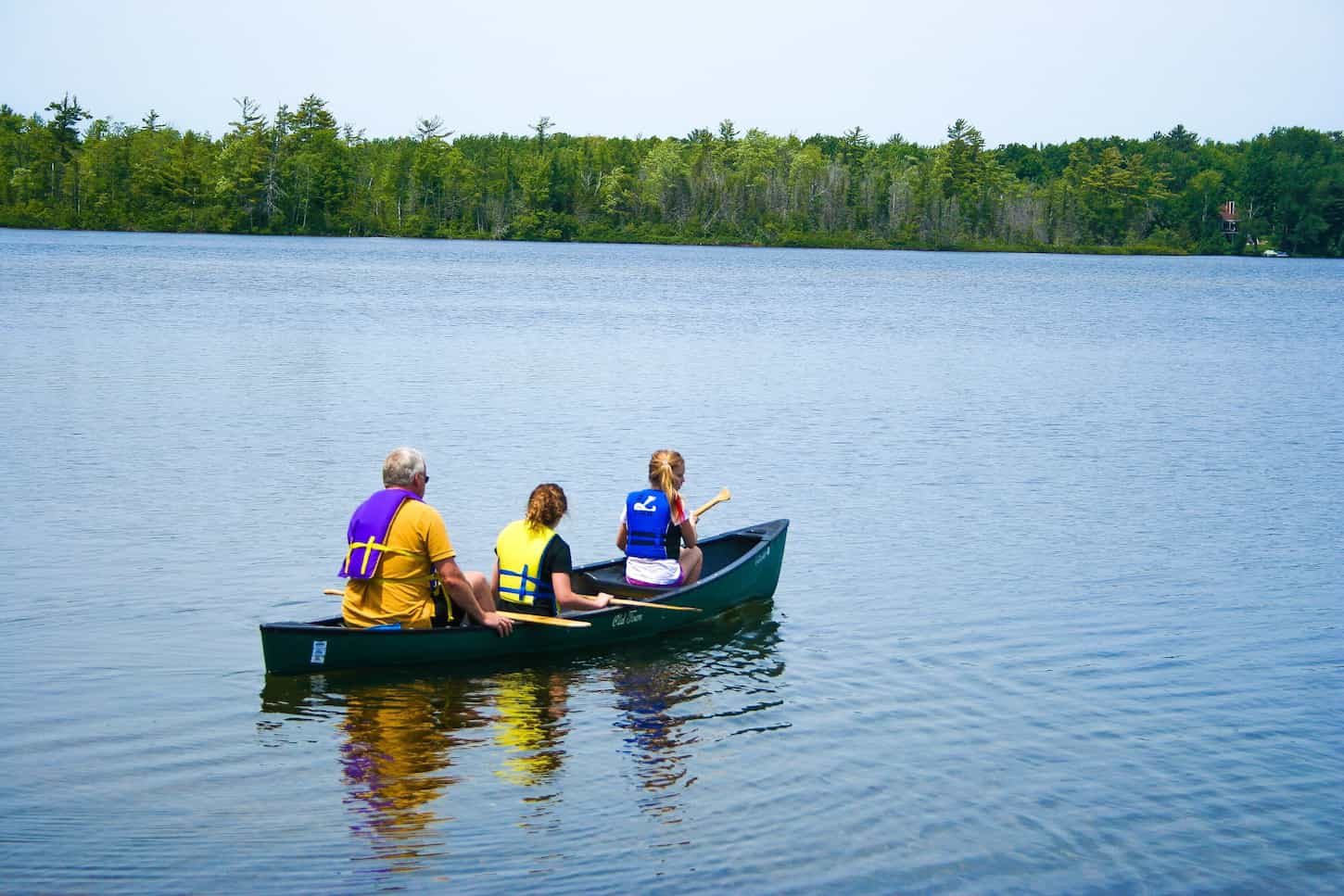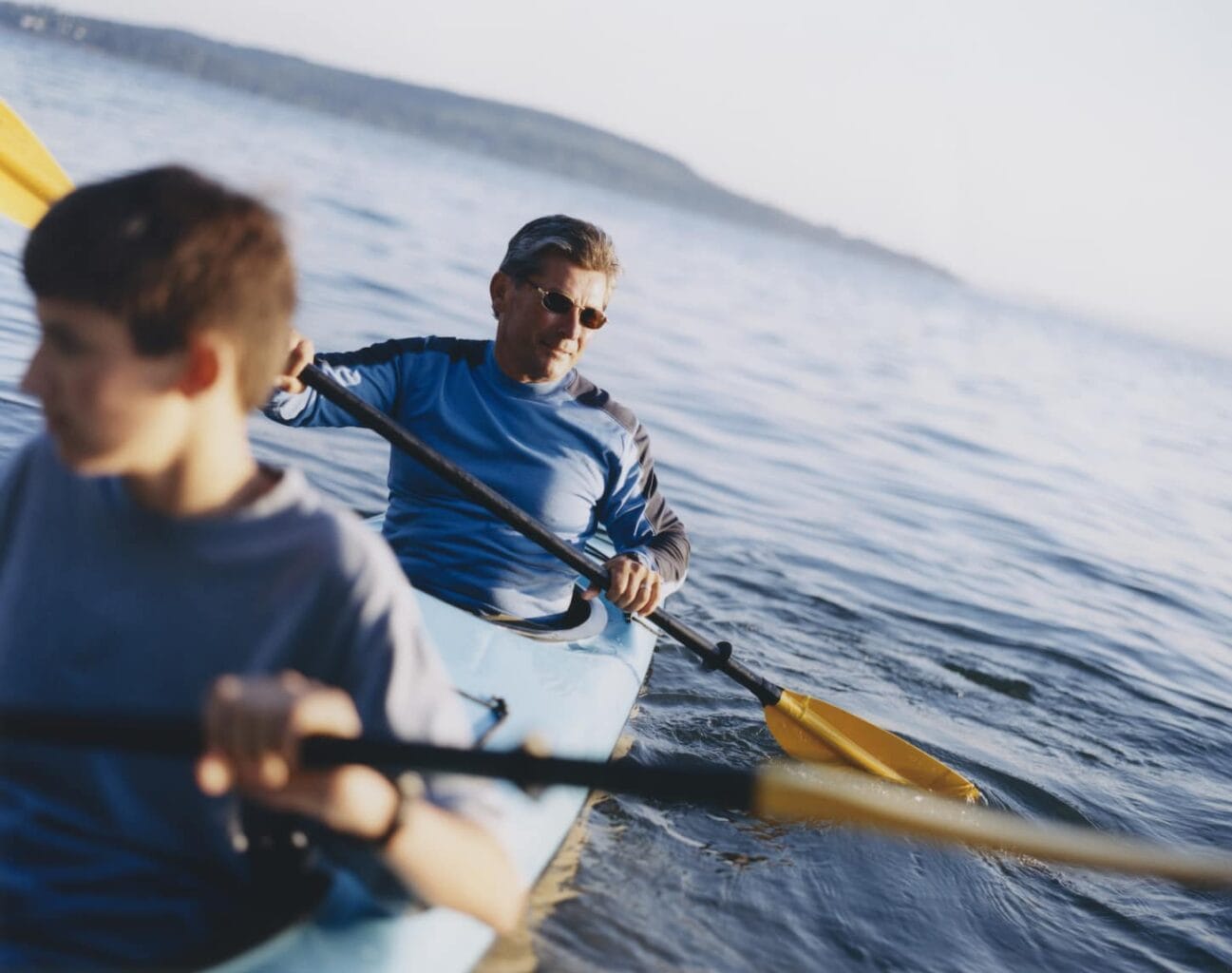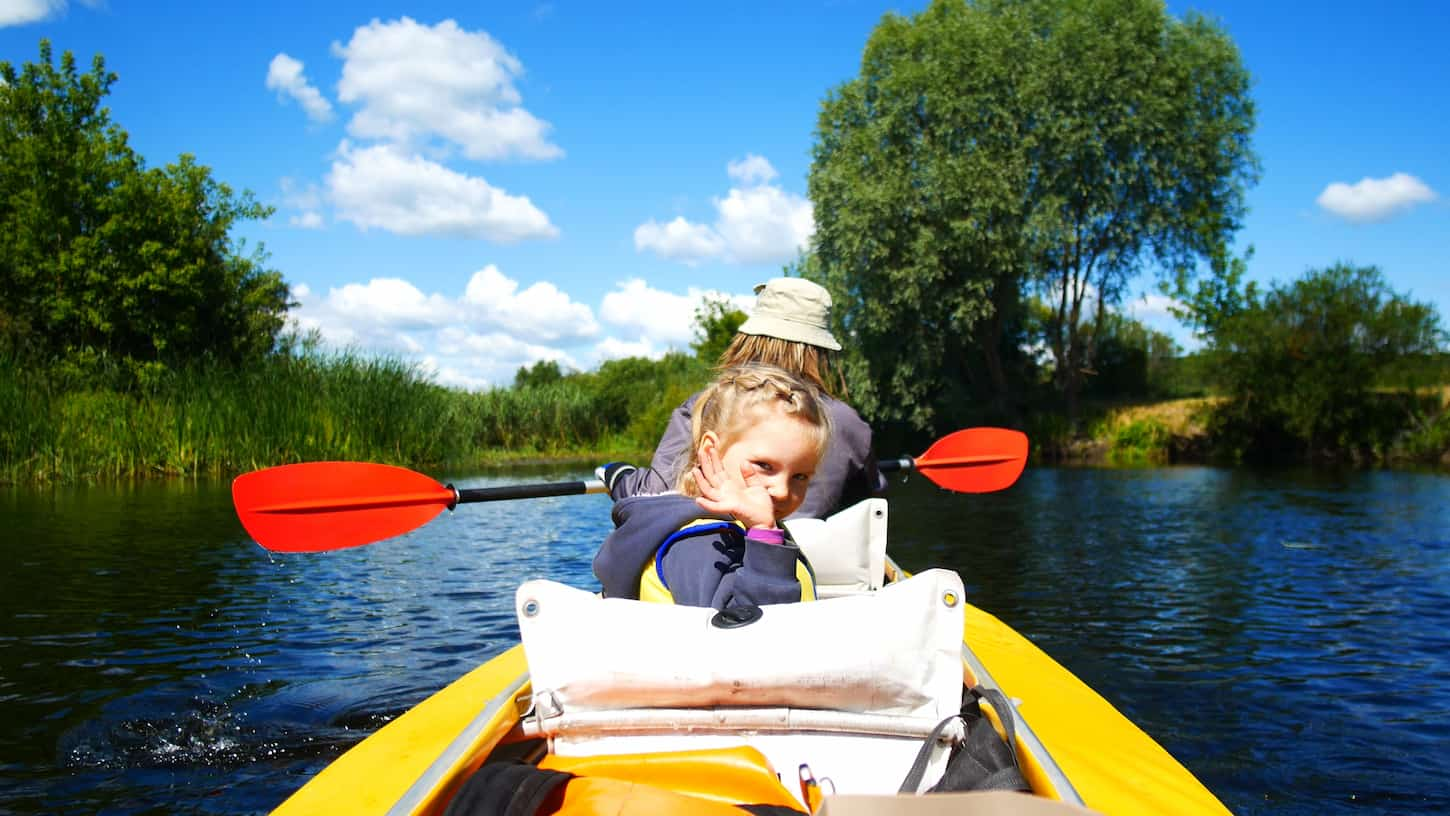If someone is looking for activities that keep them fit and out in nature, they might have considered a paddle sport such as kayaking, canoeing, SUPing, or rafting. Kayaking is one of the safest and most popular paddle sports, and we’ll show why it’s a fantastic way to spend time with the family.
Kayaking as a family is a great idea because it helps us bond and improves family relationships. It is a fantastic way to spend a few hours, days, or even a week together, and it will keep us fit and healthy while we learn about nature and the great outdoors.
All family members older than two years can enjoy kayaking and even take their dogs. It’s one of the most rewarding activities we can do as a family, and it’s pretty safe. In this article, we’ll give essential safety advice along with the many reasons why kayaking is a great idea.

Is Kayaking Good for Kids?
Kayaking is good for kids because it helps them learn about water safety and develop confidence in the water. It gives them a sense of freedom and adventure, keeps them fit and healthy, and helps them to develop their teamwork skills.
Kayaking is more than a sport, it can become a hobby and inspire passion in children, and it comes with endless learning opportunities. It gives children a different world perspective and is a fantastic stress-relieving activity.
The best way to get children enthusiastic about kayaking is by making it exciting. Plan the trip together and go to interesting places. Make sure to take binoculars so they can get up close to wildlife.
Important note: always follow proper water safety rules when out on the water. Life vests are a great idea, even for family members who are strong swimmers. Always be aware of the weather and how the local water can change throughout the day.
For example, when visiting Yellowstone Lake last year, we considered renting some small boats (and maybe a kayak) to go out in the afternoon. Thankfully, we asked a park ranger first. He discouraged it, as (during that particular season) the lake tends to get choppy in the afternoon, becoming dangerous for even the most experienced of boaters. We went hiking instead.
How Old Should a Child be to Go in a Kayak?
According to the US Coast Guard, children should not go in a kayak (as a passenger) until they are two years or weigh 18 lbs, and they should wear a personal flotation device (life vest). Some seasoned kayakers will take children as young as 12 months old, but this is not recommended for beginners.
Young children should start sitting in the small compartment in the middle of the kayak where equipment is stored – this is known as duffing. Sitting in the duffing is only suitable for short journeys.
From 3- 4 years old, they can go in the front seat of a tandem kayak, and from 6-7 years, depending on their development, they can go in their own kayak in calm waters, especially if we tow them (or at least have a tow line connected).
Encourage children to use the paddle from around five years old. Ensure they have a small child-sized paddle because they likely won’t have the strength to use an adult one.
Before letting a child go alone in a kayak, ask yourself these questions:
- Are they strong and sensible, and can they handle the kayak?
- Can they handle themselves in the water if (or when) they take a spill?
If the child is okay, let them try a short distance alone. If not, keep practicing in a tandem kayak until the child is stronger and ready to go alone.
When starting, stick to short, half an hour journeys and build the time up slowly. Only take small children kayaking if you’re experienced, and regardless of their age, all children must wear a Personal Floatation Device (PDF) or life vest.
Use a US Coast Guard-approved model with neck support, and make sure the child can float in the water.
Children’s PFDs come in three sizes:
- Infant – 8-30 lb.
- Child – 30-50 lb.
- Youth – 50-90 lb.
Children must be able to swim before they go kayaking, and you should never strap them in. Encourage children to get physically fit before going in the water with exercises at home and to watch video lessons on YouTube.
Parents should also ensure children can comfortably get in and out of the kayak and use the paddle to push away, turn and stop.
Can a Child Sit on Your Lap in a Kayak?
It is not a good idea for children to sit on their parent’s lap in a kayak because they will restrict movement. Also, we might injure them if we have to do a fast maneuver, which is not very comfortable for the child or us.
Generally, it’s not safe for a child to sit on someone’s lap in a kayak. Toddlers and small children should sit in the center of the kayak, and children between 3-4 can sit in the front seat of a tandem kayak.
What are the Disadvantages of Kayaking as a Family?
The main disadvantage of kayaking as a family is that it can be dangerous if parents are not experienced and do not observe safety advice. Kayaking equipment is also expensive, and there is no way to guarantee that the children will enjoy it.
Here’s a list of the disadvantages of kayaking as a family.
Disadvantage #1 – It’s a big investment
Kayaking equipment is a big investment. Not only do we need kayaks, but we also need safety equipment. This includes extras, such as PFDs, helmets, a roof rack, waterproof bags, wetsuits, paddles, and tow lines.
Before committing, it’s a good idea to see if the family enjoys kayaking first. Take kayaking classes, book a guided tour, rent the equipment or try a friend’s kayak. If the family loves kayaking, parents can confidently invest in kayak equipment.
Disadvantage #2 – Water sports can be dangerous
Kayaking can be dangerous if we’re inexperienced and don’t follow safety advice. Drowning, cold-water shock, sun exposure, change in weather conditions, getting lost, and hitting white water or obstacles are all real risks. We can keep these risks to a minimum by following safety advice and best practices.
It’s crucial to have the correct safety equipment, plan the journey carefully, and not push anyone past their skills. We can keep the dangers to a minimum by being prepared for every eventuality and carrying essential safety equipment.

What are the Advantages of Kayaking as a Family?
Kayaking is a fantastic way to bond as a family because they must work as a team. It is also a good form of exercise and an effective stress reliever. Families can combine kayaking with other activities, which is the perfect way to spend time in nature.
Let’s take a closer look at the advantages of kayaking as a family below.
Advantage #1 – It will help you bond
Kayaking will bring us closer as a family and deepen emotional ties, which are beneficial for child development. It will also improve communication skills while working together and creating awesome family memories.
Family bonding is more important than ever in this age of smart devices, and kayaking is the ideal way to connect with each other and enjoy countless memorable experiences.
Advantage #2 – You can combine kayaking with other activities
When we go kayaking, we can combine it with other outdoor pursuits such as swimming, fishing, and camping. It’s a fantastic way to explore the great outdoors, and with binoculars, we can spot birds and animals along the way.
Combining kayaking with other activities is the perfect way to keep children engaged and interested.
Advantage #3 – It’s a good form of exercise
Kayaking is a fantastic way to get exercise. We can do it at a leisurely, gentle pace or faster for a cardiovascular workout. It’s low impact, burns lots of calories, and works out most muscle groups, but it is particularly good for the core and upper body.
Advantage #4 – It gets you out in nature
One of the most appealing things about kayaking is that it gets us out in nature, breathing fresh, clean air. Kayaks are quiet and peaceful, and we will see plenty of wildlife and experience spectacular scenery that we wouldn’t see from a footpath or road.
We can also use our trip to learn wilderness and survival skills with the family.
Advantage #5 – It boosts self-esteem
Children become more confident when they kayak, which will boost their self-esteem and make them more confident in other situations. They will also learn about teamwork, cooperation, self-discipline, and self-control.
Advantage #6 – It’s stress relieving
Kayaking is stress relieving because it’s calming and relaxing to be in the water. It also provides a physical workout – one of the best ways to relieve stress. Being outside in nature is also stress-relieving and is a great way to spend time bonding with family experiences.
Advantage #7 – It’s a learning experience
When parents go kayaking, they will naturally find themselves teaching the kids about many things. They will learn about navigation, currents, local animals and wildlife, and how to be comfortable in the water and nature.
Children will also develop a strong sense of responsibility when they go kayaking.

What Extra Safety Precautions Should a Family Take While Kayaking?
To reduce the risks associated with kayaking, plan each trip carefully. Check the weather and water conditions before heading out, and have the correct safety and outdoor supplies. It is also a good idea to set ground rules – so everyone knows what’s expected of them.
If you want to know more about staying safe while kayaking, take a look at these safety tips:
Tip #1 – Pick your location and plan your trip carefully
One of the most crucial safety tips about kayaking is choosing a suitable location and planning the trip carefully. Beginners should practice in a place with calm, slow water.
Small lakes are an ideal place to practice, and we can work our way to more challenging waters, like rivers and the sea, as we build our skills.
Before heading out, check the weather forecast for the day ahead and the water temperature, and dress accordingly. Always let someone know where you’re going and how long you plan to be away.
Tip #2 – Make sure you have the right supplies
The risks of kayaking increase without the right supplies, so pack the correct equipment on every trip. When we go on adventures in nature, we must prepare for every eventuality.
Here’s a list of some of the essential safety gear we need for kayaking:
- A floatable tow line for each boat (for tying boats together only – don’t be tying boats to people, especially the children).
- A paddle float
- A throw bag (or dry bag)
- Rain gear
- Hat
- Sunscreen
- Sunglasses
- Emergency whistle
- Maps and compasses
- Helmet for kids
- Cell phone and/or camera (put it in a watertight, floatable bag to keep it safe and ready to use when needed)
- Bug spray
- Snacks (Healthy, nourishing, high-energy food like nuts and seeds, dried fruit, and veggies)
- Plenty of water to stay hydrated. Make sure you take extra in hot weather!
Tip #3 – Make sure you have the right clothing
It’s essential to have the correct clothing when kayaking, especially when it’s cold. It’s better to wear breathable, water-resistant layers, including a rashguard, to stay warm.
It’s a good idea for children to wear a neoprene wet suit and neoprene shoes, especially if the water is below 60 degrees Fahrenheit. Take spare clothes for everyone, because being wet on the way home isn’t fun.
Tip #4 – Set rules
To keep everyone safe on a kayaking trip, it’s a good idea to set ground rules. Explain that sticking to the rules is essential for safety and ensure everyone is clear about them. Parents should include rules like the following:
- Always wear a life jacket.
- Do not stand on the kayak.
- Don’t get in or out without permission.
- No fooling around like rocking or reaching out of the kayak.
Tip #5 – Make sure there are enough adults to children
Beginner kayakers should have one adult per child until they all get used to using the kayak and equipment. As we develop skills and get to know everyone’s abilities – there can be fewer adults per child.
Adults must keep children in front of their view. Let the older ones take the lead and keep pace with the weakest group members.

Best Products For Family Kayaking
Having the right equipment always makes life easier and safer whenever you do a sport.
Best Life Vests (Personal Flotation Devices)
Always get PFDs that the US Coast Guard approves. Here’s another cool tip: always pick the obnoxious neon colors for PFDs and swimsuits, as they show up better against water than the regular colors.
Here are a few easy options on Amazon, although I also like to shop for PFDs from Costco during the warmer months.
- Kids need smaller-sized flotation devices, like this Stohlquist vest with a grab handle (one of my favorite features!).
- For adults, get a vest like this Hardcore Water Sports brand PFD, which comes in various colors and sizes.
Best Kayaking Products (in general)
- Paddle: You’ll want a good paddle, and this Pelican brand paddle is lightweight and can be disassembled for storage. Never forget to think about storage!
- Paddle Float: You’ll likely lose a paddle during a water re-entry if you don’t have a paddle float. This paddle float self-inflates so you can focus on getting back into the kayak rather than hanging onto the paddle.
- Dry Bag: When participating in water sports, odds are you will want to keep some stuff dry. That’s when a floatable dry bag becomes your best friend.
- Waterproof Phone Bag: If all you’re bringing is a phone (or you want to be able to take some pictures), you’ll also want a waterproof phone bag. We’ve used these waterproof phone cases boating and on the water rides at theme parks, and they work great. We test them before each use because that’s how we roll.
- Swimsuits: if you’re buying a regular swimsuit, pick a neon-colored one of whatever style you want, although I recommend getting a rash guard (swim shirt), no matter how likely you think a sunburn is.
- Wet suits: The exact size and thickness you’ll need depend on where you tend to go swimming. We visit mountain lakes a lot, so we got each of our children a long-sleeved wetsuit, much like this one.
- Water shoes: We get each family member a pair of water shoes like these. As for shoes, I don’t worry about the color too much. But remember that they can get lost or outgrown pretty quickly, depending on who’s wearing them.
Best Kayaking Products (when kids are involved)
- Kids’ Kayak: Once you’re ready to invest in a kayak for your kids, this Pelican brand kayak is a great option. It’s the brand we’ve used and loved when we go kayaking, although I’ll admit we’re only still renting (and haven’t purchased our kayaks yet).
- Floating Tow Rope: You’ll want a floating tow rope (like this one on Amazon) for kayaking with kids. That way, you all stick together. This may be a little overkill, but is there such a thing as overkill related to safety? I’d vote no.
Key Takeaways and Next Steps
If parents want to go kayaking with their family before investing in the gear, renting or borrowing some kayaks to see if they enjoy it first is a good idea.
Before hitting the water, take some classes, watch video lessons on YouTube, and get familiar with the equipment onshore first. Start on calm waters, like a still lake, and work your way up to rivers.
We can take children in the kayak from two years old and sit them in the equipment compartment – not on our lap. From 3-4 years, children can sit on the front seat of a tandem kayak, and from around 6-7 years, they can go in their own kayak.
Never tie children to a kayak, and ensure they wear a Personal Floatation Device (PFD) at all times.
Resources
Learning from your own experiences is important, but learning from others is also smart. These are the sources used in this article and our research to be more informed as a family of sports nuts wannabes.
- Canoeing and kayaking – preventing injury. (n.d.). Better Health Channel. https://www.betterhealth.vic.gov.au/health/healthyliving/canoeing-and-kayaking-preventing-injury
- How to Choose PFDs (Life Jackets). (n.d.). REI. https://www.rei.com/learn/expert-advice/personal-flotation-device.html
- How to Kayak: The Basics. (n.d.). REI. https://www.rei.com/learn/expert-advice/getting-started-kayaking.html
- How to Kayak with Kids. (2021, September 2). Kayak Help. https://www.kayakhelp.com/kayaking-with-kids/
- Is Kayaking Dangerous? – A Guide to the Dangers of Kayaking and How to Avoid Them. (2021, September 1). Kayak Help. https://www.kayakhelp.com/is-kayaking-dangerous/
- Kayaking information (n.d.-a). https://kayakaddicts.com/is-kayaking-dangerous/
- Kayaking with Kids. (n.d.). REI. https://www.rei.com/learn/expert-advice/kayaking-with-kids.html
- Levesque, A. (2021, March 30). Kayaking with the Family. Paddling.com. https://paddling.com/learn/kayaking-with-the-family
- Stuppy, G. (2022, May 12). A Complete Guide to Canoeing and Kayaking with Kids and Teens. Chasing ADVNTR. https://www.chasingadvntr.com/kayaking-with-kids/
